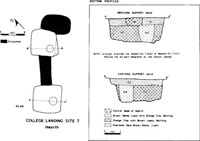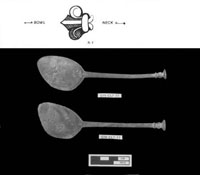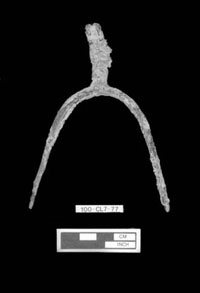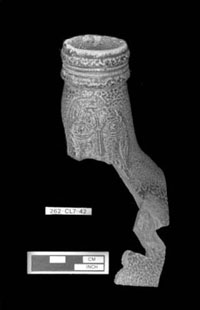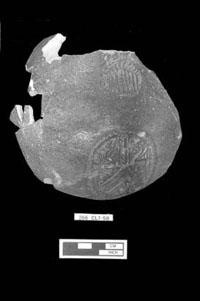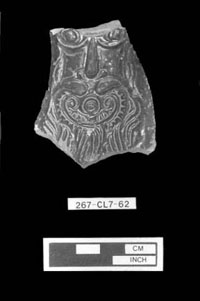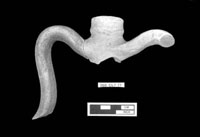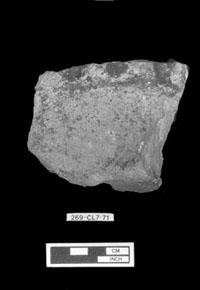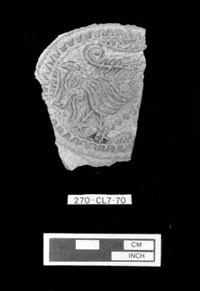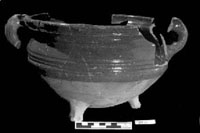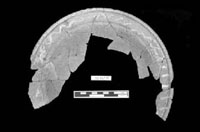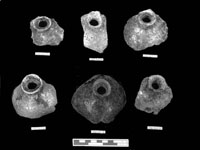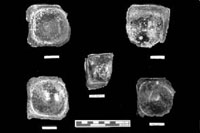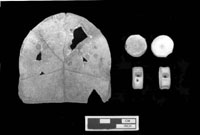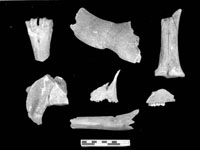Archaeology at Port Anne: A Report on Site CL7, An Early 17th Century Colonial Site
Colonial Williamsburg Foundation Library Research Report Series - 307
John D. Rockefeller, Jr. Library
Colonial Williamsburg Foundation
Williamsburg, Virginia
2002
Colonial Williamsburg Archaeological Reports
Archaeology at Port Anne:
A Report on Site CL7,
An Early 17th Century
Colonial Site
Report submitted by:
Office of Archaeological Excavation
Department of Archaeology
Colonial Williamsburg Foundation
Marley R. Brown III
Principal Investigator
July 1987
Re-issued
June 2001
Table of Contents
| Page | |
| Introduction | 1 |
| Acknowledgments | 6 |
| Historical Background | 8 |
| Goals and Methods | 11 |
| Graveyard Area | 14 |
| Area East of Hague Close: The Domestic Site | 24 |
| Summary | 40 |
| Conclusions | 42 |
| Recommendations | 44 |
| References | 45 |
| Appendices | 47 |
| 1. Descriptive Artifact Catalog | 47 |
| 2. Faunal Overview | 80 |
| 3. Artifact Inventory | 87 |
| Page | |
| Figure 1. Corporate limits, City of Williamsburg and Environs | 2 |
| Figure 2. Sites located during the 1986 archaeological survey | 3 |
| Figure 3. Plan of features located at CL7 during initial survey | 4 |
| Figure 4. Conjectural location of the 1634 palisade | 9 |
| Figure 5. Feature formation process | 12 |
| Figure 6. Overall plan, graveyard area, CL7 | 15 |
| Figure 7. Human remains found in Grave 3 | 16 |
| Figure 8. Position of coffin nails, Grave 5 | 17 |
| Figure 9. Human remains found in Grave 5 | 18 |
| Figure 10. Detail of human skull, Grave 5 | 19 |
| Figure 11. Human remains found in Grave 7 | 20 |
| Figure 12. Human remains found in Grave 8 | 21 |
| Figure 13. Detail of Bellarmine mask from Grave 5 | 22 |
| Figure 14. Overall plan, area east of Hague Close | 25 |
| Figure 15. Parallel fence lines | 26 |
| Figure 16. Fence lines | 28 |
| Figure 17. Shed(?) | 29 |
| Figure 18. Shed and possible hearth features at Flowerdew Hundred | 30 |
| Figure 19. Trash pit | 31 |
| Figure 20. Borrow pit feature | 33 |
| Figure 21. Domestic clay smoking pipes from the borrow pit feature | 35 |
| Figure 22. Limits of April 1987 extension | 36 |
| Figure 23. Supposed chimney base feature | 37 |
| Figure 24. Supposed chimney base feature (excavated) | 38 |
Introduction
The area of Williamsburg, Virginia known as College Landing or Port Anne is located between South Henry Street and College Creek, on the southern edge of the city limits. The landing area served throughout most of the eighteenth and part of the nineteenth centuries as Williamsburg's major port, linking it to local and European trade routes via the James River. A similar port, Capitol Landing, was established on the north end of town, accessing Williamsburg to the Chesapeake Bay by way of Queen's Creek and the York River. Both ports were about a mile from the center of town.
Before the establishment of the College of William and Mary in 1693 and Williamsburg in 1699, this area between the York and the James was called Middle Plantation and College Creek was known as Archer's Hope Creek. This report is primarily concerned with a site dating to this early Middle Plantation Period.
In the fall of 1985, the City of Williamsburg contacted Colonial Williamsburg's Office of Archaeological Excavation regarding an archaeological survey of a portion of the College Landing Area. Most of what was College Landing had been purchased by developer Gerald S. Divaris and was slated to become a new residential area called Port Anne. The portion of College Landing concerning the City was that section appearing on the Matthew Davenport Map of 1774. This became referred to as the "platted portion."
During the late summer and fall of the following year, a Phase I and II investigation of the area was conducted. The purpose of this type of survey is to locate and archaeologically test sites of historical or prehistorical significance and make recommendations regarding the fate of such archaeological sites. In addition to surveying the so-called "platted portion," Port Anne developer Gerald Divaris allowed a survey of his property as well. Seven sites were identified during the survey, four within the platted portion and three to the west and north. Five of the sites were historic, dating from the eighteenth century, and one was Indian, probably dating to about 1000 A.D. The remaining site was historic, but much earlier than the others, dating to the first half of the seventeenth century (Figure 2).
The latter site was an accidental find discovered by the surveying archaeologists while a road, later known as Hague Close, was being constructed. The survey team had been previously excluded from the area by the contractor because of the dangers inherent in the tree-felling phase of construction. As the topsoil and plowzone were being stripped away in preparation for the road bed, numerous archaeological features, including two human burials, several post holes, a trash pit, and a boundary ditch, were discovered. In light of these finds, contractor Jack L. Massey was kind enough to move his operation to another part of the Project while salvage excavations were underway. The site was given a designation (College Landing Site #7, or CL7), and the features were mapped and excavated (Figure 3).
After the features which were in immediate danger were excavated, further testing in the area revealed a fairly large seventeenth century site containing several
2
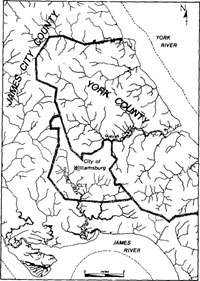 Figure 1. Corporate limits, city of Williamsburg and environs.
3
Figure 1. Corporate limits, city of Williamsburg and environs.
3
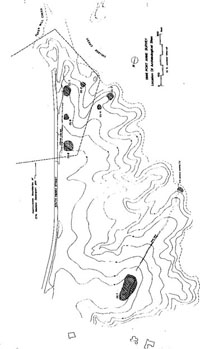 Figure 2. Sites located during the 1986 archaeological survey.
4
Figure 2. Sites located during the 1986 archaeological survey.
4
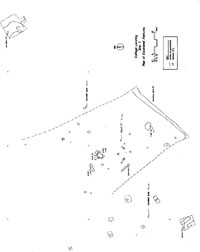 Figure 3. Plan of features located at CL7 during initial survey.
5
more graves and a feature, thought to be a house cellar, containing a great deal of seventeenth-century material. It was, however, beyond the scope of the survey to investigate further. The importance of the site was emphasized in Gregory J. Brown's report on the Phase I and II Project (Brown 1986), and funds were made available from the City of Williamsburg, the developer, and the Colonial Williamsburg Foundation for a more intensive investigation of the site.
Figure 3. Plan of features located at CL7 during initial survey.
5
more graves and a feature, thought to be a house cellar, containing a great deal of seventeenth-century material. It was, however, beyond the scope of the survey to investigate further. The importance of the site was emphasized in Gregory J. Brown's report on the Phase I and II Project (Brown 1986), and funds were made available from the City of Williamsburg, the developer, and the Colonial Williamsburg Foundation for a more intensive investigation of the site.
This more intensive study, called by archaeologists a "Phase III Salvage Excavation" was begun on December 22, 1986 and continued, initially, through the first week in March, 1987.
Acknowledgements
Numerous people were responsible or helpful in the successful completion of this phase of archaeological investigation at College Landing. Principal among these were Gerald S. Divaris of Divaris Real Estate, developer of the Port Anne Project, who gave freely his personal and financial support to the excavation of this important seventeenth-century site. Equally supportive was Williamsburg City Manager Frank Force, Mayor John Hodges, and the rest of the City Council who funded the initial survey and a third of the costs for the excavation of CL7. Colonial Williamsburg's Director of Research, Cary Carson, and his enthusiasm made funds available from the Foundation and offered his knowledgeable insights into the archaeology of seventeenth-century Virginia.
Marley R. Brown III, Director of the Office of Archaeological Excavation for the Colonial Williamsburg Foundation, was the Principal Investigator. It was his responsibility to initiate, administer, and direct the project and guide the completion of this report.
Also very helpful in expediting the project were Colonial Williamsburg Vice Presidents Robert C. Birney and Norman G. Beatty, as well as City Attorney Joseph Phillips.
Much credit also goes to the core excavation team, Nathaniel Smith, Charles Thomas, and Lucie Vinciguerra, who persevered admirably through one of the most uncomfortable and wet winters this area has experienced in a number of years. Consultant Charles T. Hodges was very helpful during the latter part of the project. His expertise and experience in early seventeenth-century colonial archaeology was quite well received and used. Meredith Moodey and Felicity Devlin, under the direction of Collections Supervisor William Pittman and Senior Laboratory Technician Leslie McFaden, did an excellent job of processing the incoming artifacts and skeletal remains. Mr. Pittman and Ms. McFaden compiled the artifact inventory and directed the clay pipe analysis which resulted in a report, produced under separate cover, by William and Mary History graduate students Christopher Hendricks and David Lester.
Joanne Gaynor, Staff Zooarchaeologist, and her assistant, Roni Polk, completed the analysis of the animal bone found during the excavation. Report drawings and photographs were the outstanding and timely work of Staff Photographer Tamera Mams.
Colonial Williamsburg's Resident Archaeologist, Ivor Noël Hume, was kind enough to offer his insights and expertise regarding the archaeology of the site and the artifacts recovered. Staff Archaeologist Gregory J. Brown, who directed the initial survey of the College Landing Area and wrote the December 1986 report on the Phase I and II archaeological investigations, was extremely helpful in offering information and assistance pertaining to his efforts during the past year.
7Thanks should also be extended to Dudley S. Waltrip and Sons, Inc. and their expert machine operator Charlie Green who carefully guided his Drott 40 around and between the trees in order to cleanly and evenly strip the site in a very short time.
Historical Background1
The Tidewater Virginia Area has been inhabited for an estimated 12,000 years. Evidence of American Indian occupation in the riverine and upland areas of the peninsula has been documented through various archaeological surveys (Hunter and Higgins 1985; Hunter, Higgins, and Hodges, in preparation; and Hunter and Kandle 1986). Most of these sites are of the Archaic (8000 B.C.-500 B.C.) and the Woodland (500 B.C.-1607 A.D.) Periods. Since no comprehensive study has been made of the Williamsburg Area's aboriginal component, little is known about the Indians of the vicinity prior to the immigration of the English in the late sixteenth and early seventeenth. centuries. Only one site, CL3, dating to the Middle or Late Woodland Periods, was located during the 1986 survey. No Indian artifacts were found during the excavation of CL7.
After the establishment of Jamestown in 1607, little interest was exhibited on the part of the early colonists to settle inland areas in Tidewater, even within the narrow peninsula between the James and York Rivers. Undoubtedly feeling somewhat vulnerable to the local aborigines (especially after the Massacre of 1622), the English confined most of their activities to the banks of Virginia's major rivers. The falling tobacco prices in the early 1620's (Craven 1970), the massacre, and the failing of the London Company spelled unfavorable economic times for most Virginia colonists. It was not until the 1630's that the economy began to improve and settlement was encouraged in the inland areas. Middle Plantation was one of the earliest and eventually the most successful inland venture in the seventeenth century.
In 1632 the House of Burgesses passed the "Act for Seating of the Middle Plantation" (Goodwin 1959) which called for the erection of a palisade2 between the James and the York, across what is today the City of Williamsburg. Settlement was strongly encouraged along the palisade in order to ensure its purpose: fencing the Indians out of the lower peninsula and fencing the livestock in. The exact location of this palisade is not known on the southern side of town, although archaeological evidence of the ditch and post holes were found on the north side of town during a Phase I survey conducted by Colonial Williamsburg's Office of Archaeological Excavation for the proposed Second Street extension (Hunter et.al. 1985). The time period and location of Site CL7 place it temporally and spatially at least near where the palisade was probably built (Figure 4). No evidence of the structure was found there, however.
One of the first residents of the Middle Plantation area was the Colony's Physician General, John Pott(s). He was apparently quite a colorful character, whose
9
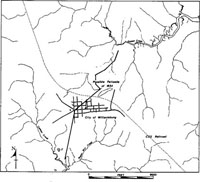 Figure 4. Conjectural location of the 1634 palisade.
10
talents as a physician were renowned and who served as governor of Virginia in 1629. He was, however, convicted of cattle theft in 1630 and was often admonished for his keeping of bad company and his taste for strong drink (Goodwin 1959). In spite of these apparent shortcomings, he remained a powerful member of the Council and in 1635 conspired in the successful ousting of Governor Harvey. Other early landholders in the area included George Menifie, Humphrey Higginson, John Utie, and Charles Leech. Unfortunately the destruction of James City County records during the American Civil War has left historians with some uncertainty regarding who owned what in the early seventeenth century. The actual ownership of site CL7 is therefore unknown. It would have been fortunate if John Potts could have been associated with the site, given his apparent notoriety. However, Colonial Williamsburg Historian Peter Bergstrom believes his residence was further south, probably around The Oaks on Henry area (Bergstrom 1987, personal communication).
Figure 4. Conjectural location of the 1634 palisade.
10
talents as a physician were renowned and who served as governor of Virginia in 1629. He was, however, convicted of cattle theft in 1630 and was often admonished for his keeping of bad company and his taste for strong drink (Goodwin 1959). In spite of these apparent shortcomings, he remained a powerful member of the Council and in 1635 conspired in the successful ousting of Governor Harvey. Other early landholders in the area included George Menifie, Humphrey Higginson, John Utie, and Charles Leech. Unfortunately the destruction of James City County records during the American Civil War has left historians with some uncertainty regarding who owned what in the early seventeenth century. The actual ownership of site CL7 is therefore unknown. It would have been fortunate if John Potts could have been associated with the site, given his apparent notoriety. However, Colonial Williamsburg Historian Peter Bergstrom believes his residence was further south, probably around The Oaks on Henry area (Bergstrom 1987, personal communication).
By 1674 Middle Plantation was a part of Bruton Parish, and a brick church was built near the present one in 1683. A church previous to the 1683 structure is believed to have existed somewhere in the Middle Plantation area, but its location is wholly unknown (Hudson 1987, personal communication).
Nathaniel Bacon met with his followers at Middle Plantation in 1676 before proceeding to burn Jamestown. The College of William and Mary was established there in 1693, and the capitol moved to Middle Plantation in 1699. The town's name was changed to Williamsburg with the movement of the Capitol and the laying out of streets and lots in an orderly fashion.
The "College Landing" area, as it has been known since the eighteenth century, played an important role in Williamsburg's commercial trade. By the first half of the eighteenth century College Landing boasted of several warehouses, tobacco houses, an inspection station, a ferry, and probably a tavern or two. It continued to be an important port until the early nineteenth century.
The CL7 site was apparently abandoned in the last quarter of the seventeenth century as indicated by the artifactual material found in the trash pit and borrow pit features. Although much of the area south of the site was used throughout the eighteenth century as a port, little further activity seemed to take place at CL7 until it was farmed in the nineteenth century. The immediate area remained in disuse much of this century until it was purchased from Duncan Cocke and the Savage family by developer Gerald S. Divaris, and slated for development.
Goals and Methods
The principal goal of the Phase III archaeological investigation was straight forward: locate and excavate all graves and as many other archaeological features such as trash pits, post holes, ditches, etc. as possible before the development was opened to the public for the purchase of lots and house construction. All of these features were to be explored before they were destroyed by this construction. The human remains were to be removed from their original graves, studied, and reinterred in a safe location. The information derived from the archaeology would culminate in the production of at least two reports, one for public information and another with more academic intent. By comparing what was found at CL7 with contemporary sites at Martin's Hundred, Kingsmill, Flowerdew Hundred, and others in Tidewater Virginia and Maryland, it was hoped that a better understanding of this somewhat murky period in the early settlement of this country could be reached.
The archaeological methods were tailored to fit the tight time frame necessary to complete the job within the allotted eight weeks. The way the site was recorded had to be a compromise between strict archaeological recovery and rough salvage. Enough time and money had been allot so that rough salvage was not necessary, but no so much of either that an extremely detailed analysis of such things as plowzone distribution, soil chemistry, or micro-faunal recovery could be attempted. Funds were available for only four excavators including the Project Supervisor. The site had been physically divided by the construction of Hague Close; the graveyard lay on the west side of the street and the apparent house site on the east. In effect, the street made two sites out of what was originally only one. Two excavators were assigned to each half, two to excavate the graves and two to excavate all the features on the east side of the street.
As mentioned earlier, both the graveyard and the domestic site were stripped of the topsoil and plowzone overburden. Both of these layers were, by their nature, highly disturbed. On sites with less time constraints and more personnel, however, the plowzone is excavated very carefully. A grid consisting of 2.5' squares is imposed on the site and each artifact recovered from each square receives a locational designation. The distribution of artifacts within the plowzone can be ascertained, indicating concentrations that probably exist in subsurface features. This is, however, a very time-consuming and labor-intensive method which would not be feasible in this case. The depth of the topsoil and plowzone varied from about one foot to eighteen inches, below which was an underlying layer of what is called "subsoil". Subsoil contains no artifacts because it was deposited before man took residence in the area. However, when the seventeenth-century colonists dug deep holes for placing house or fence posts, burying trash, or making a grave, this subsoil was disturbed. By removing the topsoil and plowzone over the subsoil, these disturbances intruding into the subsoil become clear. The graves and pits were usually of a darker color than the surrounding subsoil because of the mixing with the then-existing topsoil when they were backfilled. These phenomena are called "features" by archaeologists (Figure 5).
12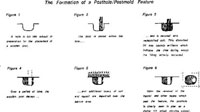 Figure 5. Feature formation process.
Figure 5. Feature formation process.
Each of the archaeological features found intruding the topsoil at CL7 were drawn on a scale map and excavated. Each feature was given a number to distinguish it and the artifacts it contained from other features. Since the kind, number, and the condition of the artifacts from individual features are very important in the interpretation of a site, it is extremely important to keep separate the artifacts removed from each feature.
All of the artifacts and the human remains removed from the site were taken to the Office of Archaeological Excavation laboratory where they were cleaned, catalogued, and studied by Colonial Williamsburg archaeologists.
Findings
Graveyard Area
Machine removal of the topsoil and plowzone overburden in the graveyard area west of Hague Close revealed eight graves in addition to the two found in the road-cut during the initial survey. Before excavation, the graves appeared as rectangular brown features in light brown subsoil. The graves were numbered one through eight in order of excavation (Figure 6).
All of the human remains, which consisted of seven adults and one child, were in a very bad state of preservation. In the case of the child, only the crowns of two teeth were found within the grave fill. No whole bones existed in any of the graves (Figures 7, 9-12). Five of the graves, including that of the child, contained numerous nails, indicating the deceased were buried in coffins. At least one of the coffins (Grave 5) appears to be of the vaulted type Noël Hume found at Martin's Hundred (Noël Hume 1982). This is indicated by the presence of nails found along the center of where the coffin lid would have been and by the position of the nails forming and arc at the foot end of the grave (Figure 8). The presence of at least one or two straight pins in all the graves reveals that all of the remains were shrouded before burial, whether or not they were buried in a coffin.
Very few artifacts, other than coffin nails, were found associated with any of the graves. The only artifacts recovered, other than nails were a fragment from the "face" portion of a Bellarmine stoneware jug, and a tiny piece of redware (Figure 13). Archaeologists once attempted to derive a date of manufacture from the degree of abstraction exhibited in the face molded onto the neck of Bellarmine bottles. The more abstract the face, the more recent the date of manufacture. According to Ivor Noël Hume (Noël Hume 1987, personal communication), the degree of abstraction in the face molded onto the stoneware bottle has nothing to do with the date it was made. A recently excavated shipwreck (The Batavia) contained a shipment of Bellarmine bottles showing varying degrees of abstraction in the bearded face. Only a general date of the first half of the seventeenth century can be derived from the stoneware and redware found in the grave fills.
The skeletal remains were removed as soon as possible after they were uncovered, fearing damage from the uncommonly cold and wet weather plaguing the excavations in January and February. Some of the more fragile fragments had to be stabilized with liquid plastic before they could be moved. Most of the skulls were removed with large blocks of earth, then excavated in the laboratory under more favorable conditions.
As many of the skeletal remains as possible will be reconstructed, with an attempt made to determine each's sex, age at death, and stature. All of the untreated fragments will be analyzed for traces of lead derived from eating off of lead glazed ceramics and pewter, as well as drinking rum from stills containing lead parts. It may be possible, also, to make correlations between the animal bones found in the trash pits to the amount of meat versus vegetables consumed by the individuals during their
15
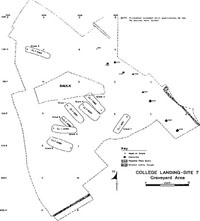 Figure 6. Overall plan, graveyard area, CL7.
16
Figure 6. Overall plan, graveyard area, CL7.
16
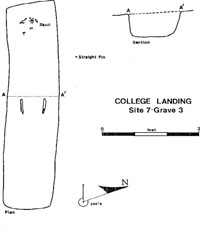 Figure 7. Human remains found in Grave 3.
17
Figure 7. Human remains found in Grave 3.
17
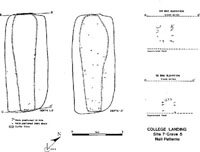 Figure 8. Position of coffin nails, Grave 5.
18
Figure 8. Position of coffin nails, Grave 5.
18
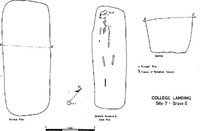 Figure 9. Human remains found in Grave 5.
19
Figure 9. Human remains found in Grave 5.
19
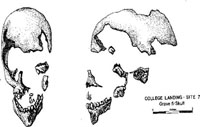 Figure 10. Detail of human skull, Grave 5.
20
Figure 10. Detail of human skull, Grave 5.
20
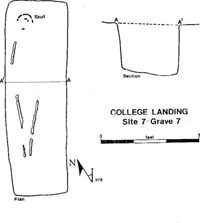 Figure 11. Human remains found in Grave 7.
21
Figure 11. Human remains found in Grave 7.
21
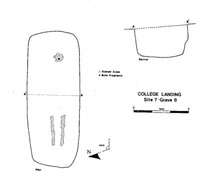 Figure 12. Human remains found in Grave 8.
22
Figure 12. Human remains found in Grave 8.
22
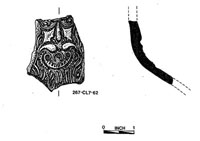 Figure 13. Detail of Bellarmine mask from Grave 5.
23
lifetimes. Of interest as well is the comparison of English and colonial dietary habits and how they changed with the colonization process. These techniques use both the isotopic and elemental composition of the human remains to look for traces of marine foods in the diet, the relative proportion of plants and animals eaten, and the use of certain types of plants, such as corn.
Figure 13. Detail of Bellarmine mask from Grave 5.
23
lifetimes. Of interest as well is the comparison of English and colonial dietary habits and how they changed with the colonization process. These techniques use both the isotopic and elemental composition of the human remains to look for traces of marine foods in the diet, the relative proportion of plants and animals eaten, and the use of certain types of plants, such as corn.
After all possible and plausible studies have been made, the remains will be reinterred at a safe place on the Port Anne property.
The graveyard area was totally excavated in the Phase III investigation. Though some area west of that which was uncovered could be stripped and investigated for more graves, the immediate area is believed to be exhausted of features. It is recommended, however, that an archaeologist be on hand when the lot is cleared for reconstruction.
Area East of Hague Close:
The Domestic Site
This area, east of Hague Close, was machine graded the same day as the Graveyard Area. The grading in both areas was somewhat complicated by a city ordinance prohibiting anyone from disturbing trees greater than five inches in diameter. This, of course, resulted in the clearing of a rather irregular area with several unexcavated "islands" of trees surrounded by portions stripped to subsoil. Approximately 3500 square feet of topsoil and plowzone was cleared in December 1986 (Figure 14).
Many of the archaeological features uncovered in this area were grouped into three "macro-features." A macro-feature is a group of features, such as post holes, that taken together make up a single entity, like a post structure or a fence line that can be studied as a unit. Other features may exist on their own, such as garden patches or wells. The three macro-features in this area consisted of two fence lines and a possible post-constructed shed. A borrow pit and several trash pits were also uncovered and excavated in this area, but were not considered macro-features because they existed independently of any other features.
Parallel Fence Lines (Figure 15)
When initially uncovered, this macro-feature was thought to be the remains of an earth-fast structure large enough to serve as a dwelling house. Most of the buildings constructed in Virginia during the first half of the seventeenth century were of this "earth-fast" type. This type of construction was carried out in one of several ways: short posts were set into the ground at regular intervals and the structure built on top of them, much like brick piers have been used for many years. Portions of buildings may have been prefabricated in sections around long poles; holes were dug where the poles needed to be buried, the panel was hoisted up, the poles then falling into the holes which were then packed with soil to stabilize them. Several of these panels were linked together, forming an enclosed structure. Other earth-fast structures were built around poles set into the ground in a rectangular pattern, the roof was placed atop the poles and the walls subsequently constructed (Carson, et.al. 1981).
Unfortunately, the series of post hole features, thought to be an eighteen by thirty foot structure, actually exhibited the characteristics of fence posts rather than structural posts. Unlike most structural posts, these post holes were not uniform in depth nor were they considered large enough to support a heavy building. Both lines of post holes were constructed on a north to south grade. It seemed unlikely that a building would have been constructed on a grade with flat ground available within several feet.
Considering no datable artifacts were recovered from any of the post hole features, it was difficult to determine whether or not the fence lines were contemporary with one another. It is possible that a fence line was moved either east or west some thirty feet for some logistical reason. It is equally possible that the
25
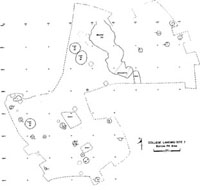 Figure 14. Overall plan, area east of Hague Close.
26
Figure 14. Overall plan, area east of Hague Close.
26
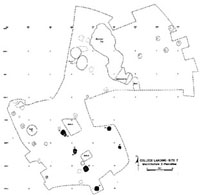 Figure 15. Parallel fence lines.
27
parallel fences enclosed a thoroughfare, perhaps the access road to the landing, or were used to corral livestock. The northern extent of the fences terminated near the center of the cleared area, the southern extent is unknown, having been destroyed by the construction of William Way.
Figure 15. Parallel fence lines.
27
parallel fences enclosed a thoroughfare, perhaps the access road to the landing, or were used to corral livestock. The northern extent of the fences terminated near the center of the cleared area, the southern extent is unknown, having been destroyed by the construction of William Way.
Another macro-feature believed to be a fence line was located near the western edge of the cleared area, also traversing the site in a north-south direction (Figure 16). Only three post holes were located in this fence line which could not be traced further because of the proximity of trees greater than five inches in diameter which could not be disturbed.
The third macro-feature identified in the area east of Hague Close appears to have been a small post-constructed shed located in the eastern portion of the cleared area (Figure 17). Measuring approximately seven and a half feet square, the structure (?) appeared to be too small for a dwelling. It may have served as some sort of outbuilding for the main dwelling discovered later some twenty-five feet to the northwest. Similar small earth-fast seventeenth century structures were recorded at Middle Plantation in Ann Arundel County, Maryland (Carson, el.al., 1981) and at a contemporary house site (44PG82) at Flowerdew Hundred in Prince George County, Virginia (Hodges, personal communication) (Figure 18).
Although post holes constituted the majority of the features encountered on the east side of Hague Close, their importance, artifactually and interpretively, was over-shadowed by a hand-full of features of other types. Three trash pits, a trench, a borrow pit, and a chimney support were also discovered on this side of Hague Close. Virtually, all of the over 5000 artifacts recovered during the excavations were taken from these features, primarily the trash pits and borrow pit feature. These features are described as follows:
Trash Pit 1 (Figure 19)
This trash pit was found in the western section of the area during the initial stripping operation. It was circular, approximately four and one half feet in diameter and about a foot and three-quarters deep. In addition to a great deal of ash, charcoal, oyster shell, and brick bits, the trash pit contained 780 artifacts dating from the first half of the seventeenth century. A complete list of the finds is described in the artifact inventory supplementing this report, but in general, the pit contained earthenwares, English flint, nails, European and English clay pipe fragments, animal bone, lead shot, case bottle glass and daub. Using a method for dating clay pipe stem fragments developed by Jean Harrington at Jamestown (Harrington 1954) and refined by archaeologist Lewis Binford (1962), a date of 1628 was derived for the filling of the trash pit. The derivation of dates for deposits relying upon the average hole diameters (they get smaller as time progresses) in the pipe stems is somewhat suspect, especially when a small sample size is used to average the diameters. The date of 1628 would indicate the mean date or mid-point in the occupation of the site. It is possible that the site could have been occupied early enough for such a mean date to be valid, but a
28
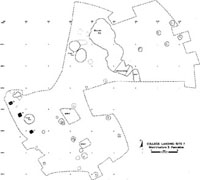 Figure 16. Fence lines.
29
Figure 16. Fence lines.
29
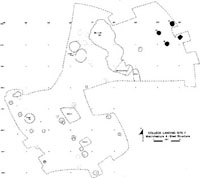 Figure 17. Shed(?)
30
Figure 17. Shed(?)
30
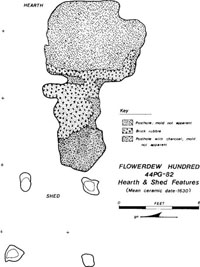 Figure 18. Shed and possible hearth features at Flowerdew Hundred.
31
Figure 18. Shed and possible hearth features at Flowerdew Hundred.
31
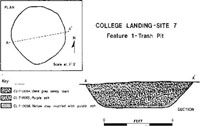 Figure 19. Trash pit.
32
date some ten to fifteen years later seems more consistent with the artifacts found in other features on the site.
Figure 19. Trash pit.
32
date some ten to fifteen years later seems more consistent with the artifacts found in other features on the site.
Two more trash pits approximately the same size in diameter were uncovered in the same area, but neither was very deep (less than half a foot). At least one of the pits was later than most features on the site because it contained wine bottle glass not manufactured until the 1650's (Noël Hume 1969).
The Borrow Pit (Figure 20)
First located during the 1986 Phase I and II survey, this feature was initially thought to be a cellar hole. The Phase I and II testing only uncovered a small portion of the feature because of the project's time restraints. The importance of the feature was, however, known at the time, due to the large number of artifacts (1000+) dating to the early seventeenth century recovered during the testing. Among these artifacts was a sixteenth century maidenhead spoon described in Brown's 1986 report (Brown 1986).
Machine stripping of the area in December revealed a feature much larger than originally anticipated. Irregular in shape, the feature measured approximately 29 feet long and as much as eleven feet wide. Rather than the rectangular shape expected from a cellar pit, the feature was, from the surface, more of a "zig-zag" configuration. Excavation of the feature revealed quite irregular sides and bottom in addition to the overall amorphous shape. Numerous shovel marks, made when the pit was dug, indicated that it was indeed excavated for some specific reason and was not in any way a natural phenomenon. The various soils filling the pit consisted primarily of silty loams with pockets of sand, mixed with a great deal of domestic trash. Over 3000 artifacts were recovered from this one feature alone.
The purpose of the large feature was, and still is, largely a mystery. The irregularity of its surface shape, sides, and bottom, the absence of any structural supports (post holes) around the pit, and the later discovery of a possible chimney base located at an oblique angle to the feature, led to the discarding of the cellar-hole notion. At present the feature is thought to be a "borrow pit", representing the digging of the clay subsoil for the purpose of making brick or daub for construction. The resulting hole was then filled with trash from the occupation of the nearby dwelling.
Using artifact categories developed by South Carolina archaeologist Stanley South (South 1977), most of the artifacts recovered from the borrow pit are of the domestic type (6196), whereas 16.3% and 14.696 are of the personal and architectural types, respectively. The domestic category does include animal bone, the largest artifact group, in addition to other domestic items such as ceramics, case bottle fragments, and utensils. The personal group contains smoking pipe fragments, clothing items, gun flints, and objects thought to be singly owned. The architectural category, of course, includes nails, brick, daub, hinges, etc. No military items were recovered. The preponderance of domestic artifacts, and the lack of military items such as armor, gun
33
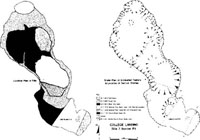 Figure 20. Borrow pit feature.
34
parts, or cannon balls identifies the site as a plantation or farm rather than a defensive location or a construction camp.
Figure 20. Borrow pit feature.
34
parts, or cannon balls identifies the site as a plantation or farm rather than a defensive location or a construction camp.
Further analysis of the clay pipe fragments recovered from the borrow pit revealed that some of the pieces from the bottom of the pit came from the same pipes as pieces recovered from near the surface. This indicates that the pit was filled in a relatively short period of time. The silt and sand layers that make up the pit fill do suggest, however, that enough time had elapsed in the filling for rainy periods or storms to have occurred. The pit was probably filled with trash over a period of several months rather than days or years.
Over 8090 of the smoking pipe fragments recovered from the borrow pit were of the domestic red clay type. Imported European and English stems and bowls were found, but in insufficient quantities to obtain an accurate date of manufacture using the Harrington/Binford method mentioned earlier. Domestic smoking pipes were made of clay which obtains a reddish color when fired. They were manufactured in the colonies during the mid-seventeenth century, at first probably by Indians as trade items, then by the colonists themselves. Many of the pipes were highly decorated, often with animal designs, rouletting, and stamps (Figure 21). They were manufactured from the second quarter of the seventeenth century throughout the remainder of the 1600's, though they appear to be most popular from the 1640-1670 period (Miller 1983).
Since both domestic pipe fragments representing many styles and European fragments were found within a feature that appears to have been filled in a short period of time, it may be assumed that both domestic and European pipes were being smoked at the same time. Additionally, there appears to be no way of dating the manufacture of red clay pipes based on variations in design.
The borrow pit feature produced the bulk of the artifacts recovered from site CL7, the majority of which were of domestic origin. At the close of the initial Phase III investigation of the site, however, no source for that debris had been found. Locating the dwelling was extremely important to an overall understanding and interpretation of this important site.
Since none of the features or groups of features located in the area uncovered in December seemed to be attributable to any kind of dwelling, it became obvious that more topsoil and plowzone had to be removed. Beginning in late March 1987, areas to the north and east of the borrow pit were machine stripped. The areas north and east of the borrow pit were selected for investigation for several reasons: the area to the south was a downward slope and therefore an unlikely site for a house; the area to the west had been investigated already; and the ground to the north and east was relatively flat. Logic also dictated that any source for the domestic trash would be fairly close by. More of the area north of the borrow pit was stripped because of a pine thicket to the east, that, by city ordinance, could not be disturbed (Figure 22).
35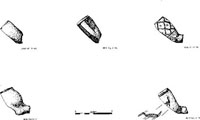 Figure 21. Domestic clay smoking pipes from the borrow pit feature.
Figure 21. Domestic clay smoking pipes from the borrow pit feature.
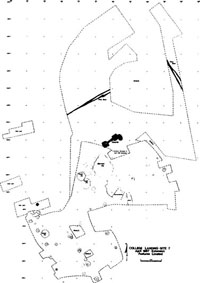 Figure 22. Limits of April 1987 extension.
Figure 22. Limits of April 1987 extension.
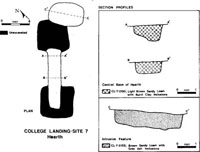 Figure 23. Supposed chimney base feature.
Figure 23. Supposed chimney base feature.
Probable Chimney Base Feature (Figures 23 and 24)
During the machine grading of the area north of the borrow pit, an archaeological feature, appearing to be the remains of a chimney base, was found. This supposed hearth feature was the only archaeological feature of significance in the area newly stripped. If indeed it was the remains of a chimney base, then it was in all likelihood the dwelling and source of the domestic debris found in the borrow pit.
Oriented on a northeast-southwest axis, the possible chimney base feature at CL7 consisted of two large post holes seven feet apart connected by a trench containing burnt clay. The burnt clay may have been the remains of poorly fired brick or daub.
Unfortunately, no datable artifacts were recovered from the feature. A domestic clay pipe stem fragment and a sliver of case bottle glass were, however, recovered from another feature which intruded into one of the post holes. Any feature intruding another must have been created after the feature it intrudes. Since the pipe stem and bottle glass recovered from the feature intruding the supposed chimney base were common artifacts of the mid-seventeenth century, it follows that the supposed chimney base was built at or before this time.
In attempting to find similarly constructed chimney base features from previously excavated contemporary sites, it must be recognized that as much as eighteen inches of soil on the site has been lost from the original seventeenth century ground surface due to plowing and erosion. This can substantially alter the appearance of a feature. What is being observed, then, is not the top of the feature, but the middle of it. What appears to be a chimney base constructed similarly to this one was found at a contemporary site at Flowerdew Hundred in Prince George County. Two post holes, approximately seven feet apart and connected by a line of brick rubble was discovered at Site 44PG82 (Figure 18). The Flowerdew feature has not, at this writing, been excavated so no further comparisons can be made at this time.
Another factor relating to the loss of soil at CL7 was the conspicuous absence of any evidence of a structure associated with the alleged chimney base feature. Most often, rudimentary early seventeenth buildings rested on posts, set in the ground at regular intervals, upon which a structure was built. The remains of these posts are readily recognizable to the archaeologist, and have provided a great deal of information regarding the early colonial architecture of Tidewater Virginia and Maryland. These large structural posts, which would define the shape and size of the building, were not evident in association with the chimney base feature. Either the posts were not set very deeply in the ground and were therefore eradicated by the subsequent plowing, or the building's sill was placed directly on the ground, leaving no evidence of ever having been there. The sill may have been set in a shallow trench, all evidence of which would have been destroyed by plowing as well.
Summary
Site CL7 was first located during an archaeological survey of the College Landing Area conducted by the Colonial Williamsburg Foundation in the summer of 1986. The survey was prompted by the development of a large portion of the area for residential housing. During the grading of what is now Hague Close, numerous post holes, two trash pits, two human graves, and a boundary ditch were uncovered. The ditch, trash pits, three post holes, and both graves were excavated immediately because of the imminent danger posed by the construction effort.
One of the interments excavated from the larger of the two graves was in good condition, the other was in a poor state of preservation. Exploration and testing to the west of the graves revealed three additional graves in what appeared to be a graveyard. None of these were excavated at the time. Further testing to the east found what was believed to be a pit cellar. This feature contained a great deal of colonial artifacts dating to the first half of the seventeenth century, including clay pipe fragments, ceramics, case bottle fragments, and a maiden-head spoon probably dating to the late sixteenth century.
Test pits were also dug along a ten to twenty foot wide road bed leading to a landing on College Creek to the east. Although it appeared that this road serviced the seventeenth-century plantation, no features or artifacts were recovered from the testing. Recommendations were made in Gregory J. Brown's report on the Phase I and II testing for a Phase III salvage investigation of the CL7 site and intact preservation of the road bed. A Phase III salvage excavation was begun in December of 1986, but the majority of the road-bed was destroyed by new road construction in January and February of 1987.
Both the graveyard area and the area east of Hague Close were machine stripped of topsoil and plowzone, revealing eight human interments and part of a fence line probably enclosing the graveyard. All of the graves fell within an area designated for the construction of a , house, so all were fully excavated. The remains, though in very poor condition, were removed to the archaeology laboratory for study.
Stripping the area east of Hague Close revealed three trash pits, another boundary ditch, many post holes, and the continuation of the supposed pit cellar. All of the features were fully excavated with the exception of the post holes which were bisected. The feature thought to be a pit cellar was in actuality more irregular in shape and was probably a borrow pit, later filled with domestic debris. In excess of 3000 artifacts from the first half of the seventeenth century were recovered from the feature.
Since a source for the considerable amount of domestic trash found in the borrow pit and trash pits east of Hague Close was not located during the initial Phase III salvage, more area to the north and east of the section stripped in December was machine graded. Few features were located in the section stripped in late March; one was, however, of significance. The remains of a possible hearth, which would indicate 41 a dwelling and therefore a source for the debris, was located just to the north of the borrow pit. Unfortunately, no other features were found in association with the supposed hearth. The house was either of block construction or the post holes dug for the sill supports had been plowed away in subsequent years. The excavations at CL7 were backfilled on April 27, 1987.
Conclusions
Site CL7 represents a fairly extensive early colonial domestic site occupied over a twenty to forty year period during the mid-seventeenth century. Its uniqueness stems principally from its location, i.e., both inland from a major waterway and within what is today the City of Williamsburg. Although we know little detail from the surviving historical sources, there is extensive documentation regarding the early settlement of the Middle Plantation area. This site, however, is the only one of the very early period of Middle Plantation ever excavated within the present City.
The archaeology at CL7 has determined that the complex consisted of what may have been a dwelling, two possible outbuildings, a series of fence lines, a graveyard assumed to be a family plot,3 and an access road which probably led to Archer's Hope Creek (College Creek) at a point approximately 1800' upstream from what was later College Landing (Brown 1986). Although no physical evidence of the palisade was found during the excavations, educated guesses based on historical research would place it near the site (Bergstrom 1987, personal communication). It is likely, then, that the complex was constructed in order to maintain and, in affect, guard the palisade, per the 1632 "An Act for the Seating of the Middle Plantation" (Goodwin 1959).
The question of who actually lived there and who owned the land during that time period, is, unfortunately, shrouded by the smoke from the records burned during the Civil War. Surviving records seem to indicate that the area occupied by CL7 was probably first owned by John Potts, but was, by the 1630's, owned by either Richard Brewster or William Davis (Boulton n.d.). Colonial Williamsburg Historian Peter Bergstrom believes that Richard Brewster was the most likely owner, and perhaps resident of CL7 (Bergstrom 1987, personal communication).
Although the assemblage of artifacts from CL7 was fairly extensive in number, there were none found that exhibited any owner's marks that would have provided a clue to who lived on the site. Additionally, even though over 5000 artifacts were recovered from the site, the vast majority of those collected from undisturbed features came from the borrow pit. Since this pit appears to have been filled in a relatively short period of time, it lacks a true representation of the materials, ceramic types, glass, etc. in use at the time. Relatively few artifacts were recovered from other features making it difficult to say anything conclusive about the social and economic position of the inhabitants of CL7.
According to Ivor Noël Hume (South 1977:221), the larger the variety of ceramic types from early seventeenth century sites, the higher the economic status of the sites occupants. The borrow pit at CL7 contained representatives of five major ceramic groups from Europe, England, and America. Eleven distinct ceramic types were included in these five major groups - a fairly diverse representation for that period in the seventeenth century. Other economic indicators recovered from the borrow pit
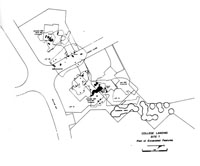 College Landing - Site 7 - Plan of Excavated Features
43
include a copper alloy book hinge, upholstery tacks, and a gentleman's spur. These items are probably not things that would be owned by the very poor indentured servant or slave, but rather objects more closely associated with a fairly well-off farmer.
College Landing - Site 7 - Plan of Excavated Features
43
include a copper alloy book hinge, upholstery tacks, and a gentleman's spur. These items are probably not things that would be owned by the very poor indentured servant or slave, but rather objects more closely associated with a fairly well-off farmer.
Recommendations
Most of the major features existing at CL7 were, in all likelihood, located and excavated during this Phase III archaeological salvage excavation. There may be other features of significance in the immediate area that the time and manpower available were unable to find and investigate. It is recommended, therefore, that any major construction on lots 10 through 20 be monitored by an archaeologist. Any major features encountered by house construction or landscaping could then be recorded and added to the present knowledge of this important site.
The only further formal archaeological testing recommended at this time would be an attempt to locate physical evidence for the 1632 palisade. This effort would be a difficult one for several reasons. Whatever evidence is left of the palisade, if any, would probably be a filled ditch about three feet wide with post holes on either side of it spaced ten to twelve apart that could be located anywhere between North Henry Street and College Creek. Likely areas such as ridges and existing ditches could be investigated first, with the effort coordinated by Colonial Williamsburg historians. The effort would require a great deal of machine stripping, however, which would lend an aesthetic appeal to the development. Should the palisade be located, however, it would help answer many questions historians have about land ownership in the seventeenth century and solve a mystery plaguing researchers for years.
Footnotes
References
- 1986
- The Transformation of Middle Plantation: Williamsburg before 1700. Paper on file, Office of Archaeological Excavation, Colonial Williamsburg Foundation, Williamsburg.
- 1962
- A New Method for Calculating Dates from Kaolin Pipe Stem Fragments. Southeastern Archaeological Conference Newsletter, 9(1):19-21. Cambridge.
- 1986
- Phase I and II Archaeological Investigations of the Port Anne Development, Williamsburg, Virginia. Office of Archaeological Excavation, Colonial Williamsburg Foundation, Williamsburg.
- 1981
- Impermanent Architecture in the Southern American Colonies. Winterthur Portfolio 16(2/3):135-196.
- 1970
- The Southern Colonies in the Seventeenth Century 1607-1689, Volume I, "A History of the South". Louisiana State University Press and the Littlefield Fund for Southern History, University of Texas.
- 1959
- A Brief and True Report Concerning Williamsburg in Virginia. Dietz Press, Richmond.
- 1954
- Dating Stem Fragments of Seventeenth and Eighteenth Century Clay Tobacco Pipes. Quarterly Bulletin of the Archaeological Society of Virginia, 9(1), Richmond.
- 1979
- Terra-Cotta Tobacco Pipes in Seventeenth Century Maryland and Virginia: a Preliminary Study. Historical Archaeology 13:14-37.
- 1986
- Phase I Archaeological Survey of the Proposed Ware Creek Reservoir Area, James City and New Kent Counties, Virginia. Office of Archaeological Excavation, Colonial Williamsburg Foundation, Williamsburg. 46
- 1985
- Phase I Archaeological Survey of the Proposed 199 Project, James City and York Counties, Virginia. Office of Archaeological Excavation, Colonial Williamsburg Foundation, Williamsburg.
- 1987
- Phase II Evaluation Study of Archaeological Resources within the Proposed Route 199 Extension Corridor, James City and York Counties, Virginia. Office of Archaeological Excavation, Colonial Williamsburg Foundation, Williamsburg.
- 1976
- A History of College Landing. Research Report No. 58, Foundation Library, Colonial Williamsburg Foundation, Williamsburg.
- 1983
- A Search for the "Citty of Saint Maries", St. Maries Citty Archaeological Series #1, St. Mary's City Commission.
- 1979
- Clay Tobacco Pipes Excavated at Martin's Hundred, Virginia, 1976-1978, in Peter Davey (ed.), The Archaeology of the Clay Tobacco Pipe, II: the United States of America. British Archaeological Series 2:3-36, Oxford.
- 1982
- Martin's Hundred, Alfred A. Knopf, New York.
- 1977
- Method and Theory in Historical Archaeology, Academic Press, New York.
Appendix 1.
Descriptive Artifact Catalog,
by William E. Pittman, Archaeological Collections Supervisor
Figure 1
A. Latten Spoon
This spoon is composed of an alloy of copper and zinc which was commonly known as latten. This example exhibits corrosion products which inconsistently cover the entire surface of the object. The handle of the spoon is ornamented with a seal top which is composed of a ballustroid knop beneath a flat disk or seal. The handle is rectangular in section with chamfered edges extending from the finial to the bowl. The bowl was originally ovoid in form and convex. A portion of the bowl has either been worn away through use against an abrasive surface or has been cut leaving the bowl irregular in shape. A maker's mark appears in the bowl near the handle in the form of an impressed fleur-de-lis. The fronds of the fleur-de-lis are not identical or symmetrical. A very similar mark has been recorded by F. G. Hilton Price as being found in London and found more frequently on latten than on pewter. Price states that this type of seal top spoon was common in England from the mid to late sixteenth century through the time of Charles II. (Price 1908:36, 70, 71)
Catalog Number: 075-CL7-77
Principal Measurements:
Overall length: 511 16" (14.48 cm)
Length of handle including seal top: 35 8" (9.234 cm)
Average diameter of seal top: 7 16" (1.134 cm)
B. Latten Spoon
This spoon is identical in form and decoration to the spoon described above. Both spoons exhibit the same maker's mark and the same general corrosion products on their surfaces. This example differs from the previous example in the nature of the ware or cutting of the bowl. The worn area of this spoon is more angular in nature resulting in a slightly greater surface area of the bowl surviving. The maker's marks are identical and could have been struck by the same die.
Catalog Number: 074-CL7-77
Principal Measurements:
Overall length: 55 8" (14.32 cm)
Length of handle including seal top: 35 8" (9.234 cm)
Average diameter of seal top: 7 16" (1.134 cm)
Figure 2
Spur
This is a copper alloy spur which is complete with the exception of the rowel. This object is inconsistently covered with green cuprous oxide corrosion products and sandy concretions. The arms of the spur are slightly splayed outward and terminate in a double-holed attachment for the leather straps which secure the spur to the boot. The arms of the spur are finely finished and polished on both the interior and exterior surfaces. The interior surface of the arms are slightly convex while the exterior surfaces are beveled with rounded edges.
Catalog Number. 100-CL7-77
Principal Measurements:
Overall length: 4 3/16" (8.178 cm)
Figure 3
Rhenish Stoneware Jug Neck
This type of Rhenish brown stoneware jugs are referred to as "Graybeards","Bellarmine" jugs, or "d'Alva bottles." These globular or pear-shaped vessels were common liquid storage containers of the sixteenth century. (Savage and Newman 1985:40) Remnants of a male face appears on the neck just below the cordoned lip. The features of the face are somewhat severe in character and unrealistic in style. No61 Hume states that the early molded faces on this type of stoneware bottle degenerated from a well formed naturalistic appearance into a stylized form by the second quarter of the seventeenth century. (Noël Hume 1978:57) The lip of the vessel is also heavily cordoned which is noted to be a later characteristic. A portion of a single pulled handle which was looped into the lip cordoning opposite the molded face survives. The body of the vessel is a grayish-tan stoneware , clay which is evenly covered with a mottled brown iron oxide under a salt glaze.
Catalog Number: 262-CL7-42
Principal Measurements:
Height of fragment: 45 8" (11.80 cm)
External Diameter of lip: 17 16" (3.671 cm)
Interior Diameter of lip: 7 8" (2.268 cm)
Figure 4
Rhenish Brown Stoneware Jug Body Fragment
This fragment of a Rhenish stoneware "Bellarmine" jug is comprised of a fine-grained grey stoneware body covered with a medium brown iron oxide engobe under a salt glaze. This vessel was globular in form and carried at least one sprigged medallion on its broadest part. The medallion consists of a heraldic coat of arms within an oval, raised border. Above the medallion, there appears the lower half of a stylized human face with a heavy beard and moustache. The beard is represented by irregular vertical raised lines which have been crudely modelled. Noël Hume notes that grotesque "Bellarmine" masks are common during the second quarter of the seventeenth century. (Noël Hume 1978:57)
Catalog Number: 266-CL7-58
Principal Measurements:
Estimated diameter of vessel at broadest point: 6" (15.27 cm)
Figure 5
Rhenish Stoneware Jug Neck Fragment
This is a face molding from a Rhenish brown stoneware "Bellarmine" jug. The body consists of a fine-grained grey stoneware clay covered with a mottled warm brown iron oxide engobe under a salt glaze. The facial features consist of a pair of protruding eyes with raised lower lids. A flattened nose with flaring nostrils appear above a stylized moustache. The mouth, or the design device which represents the mouth, consists of a raised "C" scroll with spoke-like projections. The raised, wavy lines which represent the beard are the most realistic feature of the face. This type of stylized mask is typical of "Bellarmine" jugs of the second quarter of the seventeenth century. (Noël Hume 1978:57)
Catalog Number: 267-CL7-62
Principal Measurements:
Maximum length of fragment:
Figure 6
Spanish Costrel Neck Fragment
This is the neck and a portion of the handles of a Spanish costrel. The soft body of the vessel is pinkish-tan in color and is covered with a thin whitish lead glaze which shows some signs of inconsistent decomposition. Costrels of this type were bulbous vessels with flattened sides and double curved handles which were looped into the vessel below the lip and at the shoulder. The decoration of these containers was usually restricted to a hand-painted star design in blue or brownish-red on the shoulder, usually on the flattened side. The gracefully curved handles oppose each other and are usually symmetrical in shape. The lip is reinforced with a single raised cordon. Noë1 Hume suggests that Spanish costrels of this type do not appear on Colonial Period sites much after the 1650's. (Noël Hume personal communication 6/8/87)
Catalog Number: 268-CL7-71
Principal Measurements:
Extreme width of handles: 51 8" (13.05 cm)
Interior diameter of lip: 13 16" (2.106 cm)
Exterior diameter of lip: 1¼" (3.195 cm)
Figure 7
Dutch Oven Fragment
This red earthenware fragment has been identified as a portion of a Dutch oven. (Noël Hume memo 7/10/87) The body of this ceramic fragment is a gritty reddish-brown clay with no apparent tempering agent visible to the unaided eye. The edge of the fragment has been crenelated with thumb-impressions leaving a ruffled edge decoration. The glaze on the interior surfaces only is a greenish-brown lead glaze which has been applied primarily to the interior bottom of the sherd. The exterior surfaces show some signs of blackening caused by repeated heating. The base of the fragment would appear to have been flat.
Catalog Number: 269-CL7-71
Principal Measurements:
Estimated height of fragment: 2½" (6.396 cm)
Average width of thumb impressed rim: 1" (2.592 cm)
Average thickness of body wall below rim: ½" (1.296 cm)
Figure 8
Rhenish Brown Stoneware Jug Fragment
This fragment is a decorative medallion which was customarily sprigged unto the sides of "Bellarmine" jugs. The body of this fragment is composed of a finely-grained pale grey stoneware clay with a pale brown iron oxide engobe under a salt glaze. The design of the medallion consists of a stylized rampant wolf-like animal with a curled tail, an extended tongue, a long lionesque mane, and claw-like feet. The animal is bordered by an oval shaped border with short thorn-like extensions radiating outward. A line of four raised dots underneath the animal has survived on this fragment as well as short comb-like designs which fill the negative areas not occupied by the animal.
Catalog Number: 270-CL7-70
Principal Measurements:
Average width of medallion: 2½" (6.396 cm)
Average thickness of fragment: 5 16" (0.81 cm)
Figure 9
Earthenware Cauldron
This reddish-orange earthenware vessel is composed of a fine-grained clay which is covered with a colorless to slightly greenish clear lead glaze. The vessel has been well potted as the body walls are quite thin and the elements of the vessel are well proportioned. The entire interior surface has been glazed, while only the upper half of the exterior surfaces have been covered. The pot stands on three short feet which have been looped onto the underside of the vessel. The body of the pot rises from the base to a broad waist which has been accentuated by three incised parallel grooves. At this point the vessel walls turn inward and run upward to the rim. The rim is everted and with a reinforcing ridge running underneath the slightly everted lip. The interior of the rim consists of a shallow curved ledge which could have supported a lid. Two opposing pulled handles are attached to the rim and the body just above its broadest point. The upper curves of the handles are distinctive in that they are "pinched" which is characteristic of Dutch pottery of the early seventeenth century. (Noël Hume personal communication 6/8/87) The vessel appears to be of local manufacture. There are distinct similarities between this vessel and earthenware jug (273-CL7-72) which is described elsewhere in this catalog.
Catalog Number: 271-CL7-71
Principal Measurements:
Maximum height of vessel: 7 1/16" (17.96 cm)
Approximate maximum rim diameter: 10" (25.49 cm)
Maximum diameter of vessel: 10 1/8" (25.81 cm)
Figure 10
Slipware Dish
This shallow earthenware dish is made of a fine-grained reddish tan clay and is covered with a pale yellow lead glaze. The vessel is decorated with white pipe-clay slip trailed wavy lines along the marly. The base of the vessel was not retrieved. The rim of this dish in section is distinctive in form due to the pronounced ridge running beneath the raised and rounded upper rim. This vessel is most likely of German or Dutch origin. (Noël Hume personal communication 6/8/87) The exterior surfaces of the vessel are unglazed.
Catalog Number: 272-CL7-71
Principal Measurements:
Maximum diameter of vessel: 10" (25.49 cm)
Figure 11
Earthenware Jug
This vessel would appear to be of local manufacture due to the red sandy clay which composes the body. The lower portion of the exterior of the vessel is unglazed while the remainder is covered with a clear lead glaze. There are striking similarities in form characteristic between this jug and the earthenware cauldron (271-CL7-71) described elsewhere in this catalog. The bulbous body of the jug swells outwardly from the unglazed base to a broad waist. From this point upward, the body tapers inward to a constricted neck with distinct potting marks. The rim is everted with a simple pouring spout and a single pulled handle which is lopped unto the pot at the rim and just above the widest part of the body. The upper curve of the handle is slightly "pinched" which is reminiscent of the Dutch style. The vessel walls are thin and well potted.
Catalog Number: 273-CL7-72
Principal Measurements:
Maximum height of fragment: 6 15/16" (17.70 cm)
Maximum diameter of vessel: 6 3/16" (15.76 cm)
Maximum diameter of rim: 4 1/8" (10.52 cm)
Figure 12
Case Bottle Necks
This photograph illustrates six case bottle necks which are typical of those excavated from this site. Each example displays considerable de-vitrification of the metal surface. All of the necks in this photograph have finishes with everted lips.
Catalog Number: 755-CL7-71
Principal Measurements:
Average diameter of lip: 13 16" (3.078 cm)
Average diameter of neck: 15 16" (2.43 cm)
Average height of neck and finish: 15 16" (2.43 cm)
Average diameter of bore: 5 8" (1.62 cm)
Catalog Number: 753-CL7-71
Principal Measurements:
Average diameter of lip: 1½" (3.85 cm)
Average diameter of neck: 1" (2.592 cm)
Average height of neck and finish: 11 16" (2.754 cm)
Average diameter of bore: 5 8" (1.62 cm)
Catalog Number: 752-CL7-71
Principal Measurements:
Average diameter of lip: 1¼" (3.195 cm)
Average diameter of neck: 1" (2.592 cm)
Average height of neck and finish: 13 16" (2.106 cm)
Average diameter of bore: 5 8" (1.62 cm)
Catalog Number: 751-CL7-71
Principal Measurements:
Average diameter of lip: 17 16" (3.671 cm)
Average diameter of neck: 15 16" (2.43 cm)
Average height of neck and finish: 7 8" (2.268 cm)
Average diameter of bore: 11 16" (1.782 cm)
Catalog Number: 754-CL7-71
Principal Measurements:
Average diameter of lip: 15 16" (3.347 cm)
Average diameter of neck: 15 16" (2.43 cm)
Average height of neck and finish: 13 16" (2.106 cm)
Average diameter of bore: 11 16" (1.782 cm)
Catalog Number: 756-CL7-71
Principal Measurements:
Average diameter of lip: 1¼" (3.195 cm)
Average diameter of neck: 29 32" (2.349 cm)
Average height of neck and finish: 13 16" (2.106 cm)
Average diameter of bore: 9 16" (1.458 cm)
Figure 13.
Case Bottle Bases
This photograph illustrates the interiors of five case bottle bases which are typical of those excavated from this site. All of the bases exhibit de-vitrification of the metal surface and all with the exception of the center example are composed of a pale green metal. The center fragment has dense de-vitrification over the majority of its surface which appears to darken the metal nearly to an opaque black. This example is also smaller than the others and exhibits more angularity at the edges than the others.
Catalog Number: 759-CL7-71 (upper left)
Principal Measurements:
Approximate length and width of base: 27 8" x 3" (7.368 cm x 7.692 cm)
Approximate diameter of pontil scar: 15 16" (2.43 cm)
Catalog Number: 757-CL7-71 (upper right)
Principal Measurements:
Approximate diameter of pontil scar: 3 4" (1.944 cm)
Catalog Number: 750-CL7-71 (center)
Principal Measurements:
Approximate width of base: 2¼" (5.748 cm)
Approximate diameter of pontil scar: 11 16" (1.782 cm)
Catalog Number: 758-CL7-71 (lower left)
Principal Measurements:
Approximate length and width of base: 3" x 3" (7.692 cm x 7.692 cm)
Approximate diameter of pontil scar: 15 16" (2.43 cm)
Catalog Number: 760-CL7-71 (lower right)
Principal Measurements:
Approximate diameter of pontil scar: ½" (1.296 cm)
Figure 14
Iron Nails
These are hand wrought nails which are typical of those found on this site. Though these examples have not been cleaned, they are relatively free of active corrosion. All of the nails exhibit rose heads and the three examples which are complete or nearly so display sharp as well as flat points. All are hammered from square or rectangular stock.
No catalog numbers have yet been assigned to these nails.
Principal Measurements: (from left to right)
- 1.2 3/16" (5.586 cm) nearly complete example, rose head, flat point on a rectangular shank
- 2.2 3/8" (6.072 cm) complete example, rose head, straight point on a square shank
- 3.1 1/8" (2.916 cm) rose headed rectangular shank fragment
- 4.1 7/16" (3.671 cm) rose headed square shank fragment
- 5.2¼" (5.748 cm) nearly complete example, rose head, flat point on a rectangular shank
- 6.13 4" (4.582 cm) rose headed square shank fragment
Figure 15
Figure 16
This photograph illustrates a variety of faunal bone fragments which were retrieved from this site.
Bibliography
- 1978
- A Guide to the Artifacts of Colonial America, Alfred A. Knopf, New York.
- 1908
- Old Base Metal Spoons, B.T. Batsford, London.
- 1985
- An Illustrated Dictionary of Ceramics, Thames and Hudson, Ltd., London.
Appendix 2.
Faunal Overview,
by
Roni Hinote Polk
PRELIMINARY FAUNAL REPORT
by Roni Hinote Polk
A total of 1564 faunal bones were recovered from the test excavations of seventeenth Century features conducted at College Landing during the Spring of 1987. Of these, 514 bones were identifiable to biological family with a majority of these identifiable to species as well. By and large, unidentifiable bones were categorized to large, medium and, small mammal, small mammal/ bird, bird, fish, reptile and, amphibian. In terms of percentages, 49% of the bone recovered was identifiable with 51 96 unidentifiable.
Most of the recovered bone was in a fairly good state of preservation. Some bones required consolidation and this was done by vacuum impregnation with a solution of Butvar-98 (a plastic compound) in ethanol. Bone elements with fresh breaks were mended within their specific contexts to produce more readily identifiable fragments. Many of the bones from the borrow pit contexts were complete enough to yield measurable skeletal data. This information can contribute to interpretation of animal husbandry in the 17th Century Chesapeake region. This phase of analysis is planned for the near future.
The overall sample size for all contexts from 17th-century features exceeded the minimum sample size of 1200 bones needed to obtain a unbiased total for minimum number of individuals (MNI) of specific species present. While MNI data has been compiled for the Borrow Pit contexts, a determination of total number of MNI for the site as a whole remains to be assessed. MNI data is compiled from matched pairs of elements of approximately the same size for each species present. Pounds and percentages of usable meat from each specie present at the site is then derived from the MNI totals. Although usable meat poundage was not determined for the borrow pit faunal assemblage, MNI figures for these contexts appear on page 5. Usable meat poundage data will be compiled after MNI analysis for the site as a whole has been completed.
The relative importance of certain species to foodways are sometimes indicated by their presence or absence at a specific site. Foodways is a term used to encompass all activities involved in the procurement, storage, preparation, and distribution of food items such as meat, etc. It is interesting to note that domestic mammals common in the 17th-century Chesapeake region, such as pig, cow, and sheep/goat were predominant in the College Landing faunal assemblage. However, other common domestic mammals such as horse, dog, and cat were absent. Domestic fowl identified included chicken, domestic goose, and turkey. (Domestic and wild turkey cannot be differentiated based on skeletal remains alone.) However, turkey may have been more heavily utilized than the other domestic fowl with chicken appearing to be the least important domestic fowl present.
A faunal report for previous excavations conducted in the fall of 1986 detailed the presence of wild species such as white-tailed deer, Eastern cottontail, muskrat, grey fox, and a variety of rats, ducks, turtles, and fishes. It was suggested that the presence of remains from these animals alluded to the importance of wild species in the foodways of residents at the College Landing site. The more recent excavations produced faunal remains which emphasized this point again.
At the College Landing site, deer may have been a more important resource than sheep/goat during the 17th century based upon bone fragment and MNI totals from all contexts combined. Remains of at least two species of turtle were recovered from the Borrow Pit including snapping turtle, red-bellied turtle and, Eastern box turtle. Wild fowl remains recovered from the Trash Pit included Canadian goose, Northern goshawk bones, and a probable mallard duck bone. Shark vertebrae and a white perch bone were present in the Borrow Pit. Curiously, no small wild mammal remains identifiable to specie were represented by the assemblage as a whole.
Analyses of modifications to the faunal bone from the Spring 1987 excavations are planned but not yet underway. However, faunal bone from several contexts was burnt and generally smaller in size than that which was not burnt. Evidence of chewing was seen on some bones. Butchering marks were noted for some bones but were not recorded since analyses of seasonality and marketing practices are planned for a later date.
UNIDENTIFIED BONE
| Taxon | Long Bone | Rib | Vertebra | Teeth | Cranial |
|---|---|---|---|---|---|
| Mammal | |||||
| Large | 79 | 38 | 4 | - | 28 |
| Medium | 54 | 17 | 3 | 10 | 44 |
| Small | 3 | 7 | - | 1 | - |
| Small Mammal/Bird | 3 | - | - | - | - |
| Bird | 118 | 1 | - | - | - |
| Fish | 6 spines | - | - | - | - |
| Unidentifiable | 533/101 burnt |
TOTAL UNIDENTIFIED = 1050
BORROW PIT ASSEMBLAGE
| Species | Number of Fragments | MNI |
|---|---|---|
| FISHES | ||
| Chrondrichthyes spp. (Sharks) | 4 | 1 |
| Morone americana (White Perch) | 1 | 1 |
| REPTILES | ||
| Chelydra serpentina (Snapping Turtle)(a) | 98 | 1 |
| Pseudemys rubiventris (Red-Bellied Turtle)(a) | 6 | 1 |
| Terrepene carolina (Eastern Box Turtle) | 8 | 1 |
| BIRDS | ||
| Anatidae spp. (Swans, Geese, Ducks)(a, b) | 1 | |
| Anser spp. (Geese)(a) | 1 | 1 |
| Phasianidae spp. (Chicken, Turkey, Grouse, Bobwhite)(a) | 1 | |
| Gallus gallus (Chicken)(a) | 3/1 | 1 |
| Meleagris gallopavo (Turkey)(c) | 4 | 1 |
| 84 | ||
| MAMMALS | ||
| Artiodactyla II (Pig, Deer, Sheep/Goat) | 10 | |
| Sus scrofa (Pig) | 90 | 8 |
| Odocoileus virginianus (White-Tailed Deer) | 48 | 3 |
| Bos taurus (Cow) | 148 | 7 |
| Ovis/Capra (Sheep/Goat) | 4 | 1 |
| TOTAL | 428 | 27 |
| a = | cf. (probably) |
| b = | Anatidae combined with Anser spp. |
| c = | Phasianidae combined with Turkey |
| d = | Artiodactyla II combined with Deer |
TRASH PIT ASSEMBLAGE
| Context | Species | Number of Fragments |
|---|---|---|
| CL 7-54 | cf. Branta canadensis (Canadian Goose) | 1 |
| cf. Anas platyrhynchos (Mallard Duck) | 1 | |
| Sus scrofa (Pig) | 1 | |
| Odocoileus virginianus (White-Tailed Deer) | 1 | |
| CL 7-55 | Accipiter gentilis (Northern Goshawk) | 1 |
| cf. Anser spp. (Geese) | 2 | |
| cf. Anser anser (Domestic Goose) | 8 | |
| Branta canadensis (Canadian Goose) | 1 | |
| Meleaaris gallopavo (Turkey) | 4/4 | |
| cf. Gallus gallus (Chicken) | 1 | |
| Artiodactyla II (Pig, Deer, Sheep/Goat) | 6 | |
| Sus scrofa (Pig) | 1 | |
| Odocoileus virginianus (White-Tailed Deer) | 265 | |
| CL 7-56 | Odocoileus virginianus (White-Tailed Deer) | 2 |
| CL 7-58 | cf. Artiodactyla II (Pig, Deer, Sheep/Goat) | 1 |
| Sus scrofa (Pig) | 7 | |
| Bos taurus (Cow) | 1/1 | |
| 86 | ||
| CL 7-59 | Sus scrofa (Pig) | 6 |
| Bos taurus (Cow) | 5 | |
| TOTAL | 86 | |
Artifact Inventory
College Landing
Site CL7 (44WB49)
| Context # | Qty | Description |
|---|---|---|
| CL7/2 | 1 | Buckley ware |
| 2 | Yorktown-type ware | |
| 2 | Delftware, English | |
| 2 | Delftware, English, glaze missing | |
| 1 | Delftware, English, purple manganese sponged decoration | |
| 2 | Delftware, English, blue painted underglaze | |
| 3 | Refined earthenware, glaze missing | |
| 28 | Creamware | |
| 5 | Creamware, damaged | |
| 1 | Creamware, red painted overglaze | |
| 32 | Pearlware | |
| 2 | Pearlware, 1 damaged, 1 handle fragment | |
| 6 | Pearlware, blue shell edged | |
| 2 | Pearlware, green shell edged | |
| 11 | Pearlware, blue painted underglaze | |
| 2 | Pearlware, printed flow blue | |
| 7 | Whiteware | |
| 1 | American brown stoneware | |
| 3 | Westerwald stoneware | |
| 1 | Burslem stoneware | |
| 12 | Fulham stoneware | |
| 30 | White salt-glazed, 1 rim, 1 base | |
| 1 | Chinese porcelain | |
| 1 | Chinese porcelain, painted overglaze | |
| 10 | Chinese porcelain blue painted underglaze | |
| 2 | Container glass, blue | |
| 7 | Wine bottle, green base fragments | |
| 5 | Wine bottle, green neck fragments | |
| 65 | Wine bottle, green | |
| 1 | Pharmaceutical vial, green | |
| 1 | Milk bottle | |
| 1 | Table glass, colorless, leaded | |
| 1 | Wig curler, white clay | |
| 2 | Bricketage | |
| 1 | Stone, quartzite gravel | |
| 1 | Stone, quartz gravel | |
| 7 | Imported pipe bowls, plain | |
| 2 | Imported pipe bowls, plain, with heel | |
| 8 | Imported pipe stems, plain (5/64ths) | |
| 4 | Imported pipe stems, plain (4/64ths) | |
| 2 | Imported pipe stems, plain, fragmented | |
| 1 | Unidentified metal object, iron | |
| CL7/3 | 1 | Yorktown-type ware |
| 3 | Delftware, English | |
| 1 | Delftware, English, glaze missing | |
| 1 | Delftware, English, glaze detached | |
| 1 | Delftware English, blue painted underglaze | |
| 1 | Wedgwood green-glazed ware | |
| 9 | Creamware | |
| 2 | Creamware, damaged | |
| 6 | Pearlware, damaged | |
| 1 | Pearlware, shell-edged green | |
| 1 | Pearlware, polychrome painted overglaze | |
| 1 | Pearlware, blue painted underglaze | |
| 8 | Pearlware, blue printed underAlaze | |
| 2 | Pearlware, blue printed flow blue | |
| 2 | Whiteware | |
| 4 | Westerwald stoneware | |
| 1 | Frechen brown stoneware | |
| 6 | Fulham stoneware | |
| 88 | ||
| 12 | White salt-glazed | |
| 4 | White salt-glazed, dot, diaper, basket design | |
| 6 | Chinese porcelain | |
| 12 | Chinese porcelain, blue painted underglaze | |
| 1 | English hard paste | |
| 1 | English hard paste, red painted overglaze | |
| 1 | Container glass, colorless, non-lead | |
| 8 | Wine bottle, green | |
| 1 | Wine bottle, green base fragment | |
| 1 | Table glass, colorless, leaded | |
| 1 | Window glass | |
| 1 | Aboriginal flake, retouched | |
| 1 | Slate | |
| 2 | Imported pipe bowls, plain fragments | |
| 2 | Imported pipe stems, plain (5/64ths) | |
| 1 | Imported pipe stem, plain (4/64ths) | |
| 1 | Imported pipe stem, plain (3/64ths) | |
| CL7/4 | 1 | Red-bodied slipware |
| 1 | Wig curler fragment | |
| 4 | Delftware, English | |
| 3 | Delftware, English, blue painted overglaze | |
| 1 | Refined earthenware (Canary ware) | |
| 56 | Creamware | |
| 1 | Creamware chamber pot rim sherd | |
| 1 | Creamware, polychrome painted underglaze | |
| 41 | Pearlware | |
| 3 | Pearlware, damaged | |
| 1 | Pearlware, dipped, anular decoration | |
| 8 | Pearlware, blue shell edged | |
| 1 | Pearlware, polychrome painted overglaze | |
| 8 | Pearlware, blue painted underglaze | |
| I | Pearlware, green painted underglaze | |
| 2 | Pearlware, blue printed underglaze | |
| 2 | Westerwald | |
| 1 | Fulham, overfired | |
| 9 | White salt-glazed | |
| 1 | White salt-glazed, scratched and filled, debased | |
| 3 | Whitesalt-gazed, dot, diaper, basketweave decoration | |
| 7 | Chinese porcelain | |
| 11 | Chinese porcelain, blue painted underglaze | |
| 3 | Chinese porcelain, painted overglaze | |
| 1 | Continental hard paste, polychrome painted overglaze | |
| 1 | English hard paste | |
| 16 | Wine bottle, green | |
| 1 | Wine bottle, green, base fragment | |
| 5 | Window glass | |
| 2 | Mirror glass (possible) | |
| 1 | Bricketage | |
| 1 | Faunal bone | |
| 4 | Imported pipe bowls, plain fragments | |
| 1 | Imported pipe bowls, plain, molded | |
| 4 | Imported pipe stems, plain (5/64ths) | |
| 1 | Imported pipe stem, plain (4/64ths) | |
| CL7/5 | 1 | Pearlware, polychrome painted underglaze |
| 1 | American brown stoneware | |
| 1 | Chinese porcelain, blue painted underglaze | |
| 1 | Wine bottle, green | |
| 1 | Shell | |
| CL7/32 | 5 | Nails, wrought |
| CL7/34 | 6 | Nails, wrought |
| CL7/38 | 1 | Nail, wrought, burned |
| 89 | ||
| CL7/39 | 1 | Coarseware, lead glazed |
| 1 | Yorktown-type ware | |
| 1 | Red ware, black glazed | |
| 6 | Creamware | |
| 1 | Pearlware, annular | |
| 2 | Pearlware, blue printed underglaze | |
| 2 | Pearlware, blue printed flow | |
| 1 | Whiteware | |
| 1 | American brown stoneware | |
| 1 | Fulham stoneware | |
| 2 | White salt-glazed | |
| 3 | Chinese porcelain, blue painted underglaze | |
| 1 | Wine bottle, green, base fragments, 1 w/ pontil | |
| 1 | Window glass | |
| 13 | Nails, wrought | |
| 1 | Shot and/or casting sprue, lead | |
| 1 | Clothing pin | |
| 13 | Bricketage | |
| 3 | Bog iron | |
| 1 | Aboriginal flake, quartzite | |
| 2 | Slag/clinkers | |
| 6 | Shell | |
| 3 | Coal | |
| 1 | Unidentified metal object | |
| CL7/42 | 1 | Coarseware, lead lazed |
| 20 | Red sandy ware, 2 handles | |
| 3 | Yorktown-type ware | |
| 1 | Red-bodied shpware, slip-trailed | |
| 2 | Westerwald stoneware | |
| 19 | Frechen brown stoneware, 1 handle fragment | |
| 4 | Fulham stoneware | |
| 15 | Container glass, light green | |
| 4 | Container glass, dark green | |
| 5 | Wine bottle, green base fragments | |
| 2 | Case bottle, green | |
| 3 | Pharmaceutical bottle, green lips | |
| 76 | Nails, wrought | |
| 1 | Tack, upholstry | |
| 1 | Nut, iron | |
| 1 | Rivet, Cu/Fe alloy, shoe | |
| 2 | Drawn lead | |
| 1 | Barrel hoop, iron | |
| 5 | Shot, goose | |
| 3 | Shot, musket balls | |
| 2 | Clothing pins, copper alloy | |
| 1 | Buckle, iron | |
| 2 | Bricketage | |
| I | Stone, fire-cracked quartzite | |
| 28 | English flint spalls | |
| 39 | Faunal bone | |
| 6 | Shell | |
| 18 | Imported pipe bowls, plain | |
| 1 | Imported pipe bowl, decorated (Dutch-) | |
| 1 | Imported pipe bowl, rouletted, w/ illegible stamp | |
| 3 | Domestic pipe bowls, plain | |
| 9 | domestic pipe bowls, plain, fragmented | |
| 10 | Domestic pipe bowls, decorated, 5 fragmented | |
| 5 | Domestic pipe bowls, rouletted, 2 fragmented | |
| 63 | Domestic pipe stems, 24 fragmented | |
| 24 | Domestic pipe stems, decorated | |
| 1 | Domestic pipe stem, rouletted | |
| 6 | Unidentified lead fragments | |
| CL7/45 | 3 | Coarseware Dutch- |
| 3 | Redware, dear lead glaze | |
| 3 | Redware, green lead glaze | |
| 6 | Redware, slip-trailed | |
| 90 | ||
| 2 | Delftware, Dutch, blue painted underglaze | |
| 6 | Frechen brown stoneware undecorated | |
| 1 | Wine bottle, non-diagnostic | |
| 25 | Case bottle, green | |
| 1 | Table glass, colorless, leaded, foot | |
| 122 | Nails, wrought | |
| 1 | Tack, upholstry, copper alloy | |
| 2 | Hinges, iron | |
| 1 | Drawer pull, iron | |
| 50 | English flint spalls | |
| 2 | Curtain rings, copper alloy | |
| 2 | Copper pail fragments | |
| 15 | Unidentified iron fragments | |
| 9 | Clothing pins, copper alloy | |
| 1 | Clothing pin, iron | |
| 1 | Scissors fragment, iron | |
| 1 | Clothing buckle, copper alloy | |
| 27 | Daub | |
| 3 | Bricketage | |
| 2 | Paving tiles | |
| 1 | Natural stone | |
| 6 | Shell | |
| 5 | Charcoal bits | |
| 2 | Imported pipe bowl fragments | |
| 18 | Domestic pipe bowls, plain, 14 fragmented | |
| 18 | Domestic pipe bowls, decorated | |
| 3 | Domestic pipe bowls, rouletted | |
| 138 | Domestic pipe stems, plain, 58 fragmented | |
| 6 | Domestic pipe stems, decorated, 1 fragmented | |
| 1 | Domestic pipe stem, rouletted | |
| CL7/46 | 1 | Redware |
| 2 | Red sandy ware | |
| 1 | Yorktown-type ware, pie crust edge | |
| 1 | Red-bodied slipware, Sgrafitto | |
| 2 | Delftware, English | |
| 3 | Delftware, English, blue painted underglaze | |
| 1 | Pearlware, blue painted underglaze | |
| 8 | Westerwald stoneware | |
| l | Frechen brown stoneware | |
| 2 | Fulham stoneware | |
| 1 | White salt-glazed, dipped | |
| 4 | White salt-glazed | |
| 1 | Chinese porcelain | |
| 2 | Chinese porcelain, free blown base, blue underglaze | |
| 75 | Wine bottle, green, 9 base fragments | |
| 1 | Table glass, colorless, leaded | |
| 4 | Table glass, green | |
| 3 | Decanter glass | |
| 10 | Window glass | |
| 31 | Nails, wrought | |
| 1 | Bricketage | |
| 2 | English flint spalls | |
| 1 | Bog iron | |
| 1 | Shell | |
| 3 | Coal | |
| 2 | Imported pipe bowl fragments, plain | |
| 8 | Unidentified iron objects | |
| 2 | Unidentified lead objects | |
| CL7/48 | 6 | Nails, wrought |
| CL7/53 | 18 | Redware, lead glazed |
| 1 | Delftware, Dutch, white, clear glaze | |
| 7 | Fulham brown stoneware | |
| 1 | Fulham stoneware | |
| 1 | Chinese porcelain, blue painted underglaze | |
| 7 | Wine bottle glass | |
| 91 | ||
| 33 | Case bottle glass, green | |
| 45 | Nails, wrought | |
| 1 | Gun flint, English, fragment | |
| 3 | Shot, lead | |
| 1 | Bricketage | |
| 1 | Natural stone | |
| 49 | Faunal bone | |
| 8 | Shell | |
| 3 | Charcoal | |
| 1 | Imported pipe bowl, plain | |
| 3 | Domestic pipe bowls, plain, 1 fragmented | |
| 2 | Domestic pipe bowls, decorated | |
| 12 | Imported pipe stems, plain, 5 fragmented | |
| 13 | Domestic pipe stems, plain, 5 fragmented | |
| 1 | Unidentified iron object | |
| CL7/54 | 12 | Redware, lead glazed |
| 1 | Red-boded slipware, slip glazed | |
| 1 | Frechen brown stoneware | |
| 4 | Case bottle glass | |
| 122 | Nails wrought | |
| 2 | Barrel hoop fragments | |
| 1 | Gun flint,, English | |
| 28 | English flint spalls | |
| 1 | Shot, lead | |
| 25 | Daub | |
| 3 | Shell | |
| 8 | Imported pipe bowl fragments | |
| 1 | Imported pipe bowl fragment, rouletted | |
| 48 | Imported pipe stems, plain, 5 fragments | |
| 1 | Domestic pipe stem | |
| 4 | Unidentified iron objects | |
| CL7/55 | 6 | Case bottle glass |
| 58 | Nails, wrought | |
| 113 | English flint spalls | |
| 9 | Shot/casting sprues, lead | |
| 7 | Lead waste | |
| 1 | Clothing pin, copper alloy | |
| 1 | Clothing buckle, copper alloy | |
| 4 | Daub | |
| 1 | Bricketage | |
| 223 | Faunal bone | |
| 15 | Imported pipe bowls, 14 fragmented | |
| 5 | Imported pipe bowls, rouletted, 1 w/ 'RL' stamp | |
| 50 | Imported pipe stems, plain, 21 fragmented | |
| 1 | Imported pipe stem decorated, Dutch- | |
| 1 | Unidentified iron object | |
| CL7/56 | 2 | Case bottle glass |
| 4 | Nails, wrought | |
| 1 | Gun flint, English | |
| 7 | English flint spalls | |
| 1 | Lead waste | |
| 3 | Faunal bone | |
| 3 | Imported pipe stems, plain | |
| CL7/57 | 3 | Nails, wrought |
| 1 | Escutcheon copper alloy | |
| 1 | Folded lead strip | |
| 8 | English flint spalls | |
| 10 | Faunal bone | |
| 1 | Charcoal fragment | |
| 8 | Imported pipe bowls, plain | |
| 3 | Imported pipe bowls, all heels | |
| 2 | Imported pipe stems, plain | |
| 1 | Domestic pipe stem, plain | |
| 92 | ||
| CL7/58 | 43 | Red ware, lead glazed |
| 1 | Frechen brown stoneware | |
| 7 | Case bottle glass | |
| 3 | Nails, wrought | |
| 8 | Fragments f rom iron box - | |
| 1 | Bricketage | |
| 72 | Faunal bone | |
| 2 | Worked bone | |
| 1 | Imported pipe bowl, plain | |
| CL7/61 | 148 | Nails, wrought |
| 1 | Clothing pin, copper alloy | |
| 1 | Aboriginal flake | |
| CL7/62 | 1 | Frechen brown stoneware (Bellarmine mask) |
| 126 | Nails, wrought | |
| 1 | Clothing pin, copper alloy | |
| CL7/63 | 2 | Nails, wrought |
| 1 | Clothing pin, copper alloy | |
| 1 | Natural stone | |
| CL7/64 | 87 | Nails, wrought |
| CL7/65 | 1 | Redware, lead glazed |
| 91 | Nails, wrought | |
| 1 | Gun flint, English fragment | |
| 1 | Clothing pin, copper alloy | |
| 1 | Natural stone | |
| 2 | Bog iron | |
| CL7/66 | 78 | Nails, wrought |
| CL7/68 | 1 | Redware, glaze missing |
| CL7/70 | 1 | Redware, lead glazed |
| 1 | Frechen brown stoneware, lion- medallion | |
| 8 | Frechen brown stoneware | |
| 2 | Wine bottle glass (may be case bottle) | |
| 14 | Case bottle glass | |
| 12 | Nails, wrought | |
| 1 | Hinge, iron | |
| 1 | English flint spall | |
| 1 | Clothing pin, copper alloy | |
| 1 | Clothing hook, copper alloy | |
| 1 | Natural stone, fire-cracked | |
| 54 | Faunal bone | |
| 3 | Domestic pipe bowls, 2 fragmented | |
| 4 | Imported pipe bowls, 1 fragmented | |
| 1 | Imported pipe stem | |
| 13 | Domestic pipe stems, 6 fragmented | |
| 1 | Domestic pipe stem, agatized, decorated | |
| 1 | Domestic pipe stem, rouletted, w/ incised circles | |
| CL7/71 | 1 | Coarseware, lead glazed, Dutch oven fragment |
| 40 | Redware, lead glazed (mostly 1 cauldron) | |
| 17 | Redware, slip trailed | |
| 3 | Tin enamelled ware, Spanish costrel | |
| 3 | Frechen brown stoneware | |
| 12 | Pharmaceutical glass, cupping glass | |
| 399 | Case bottle glass | |
| 106 | Nails, wrought | |
| 3 | Hinges, iron, 1 hasp | |
| 1 | French amber gun flint, spall | |
| 1 | Gun flint, English | |
| 23 | English flint spalls | |
| 2 | Lead waste fragments | |
| 9 | Unidentified iron objects | |
| 93 | ||
| CL7/71 | 1 | Pewter basin (very deteriorated) |
| 1 | Clothing buckle, copper alloy | |
| 1 | Book hing, copper alloy | |
| 16 | Daub | |
| 3 | Brick bats | |
| 1 | Natural stone | |
| 1 | Worked stone | |
| 337 | Faunal bone | |
| 27 | Shell | |
| 10 | Seeds | |
| 3 | Charcoal fragments | |
| 3 | Imported pipe bowl fragments, plain | |
| 9 | Domestic pipe bowls, 3 fragmented | |
| 15 | Domestic pipe bowls, decorated, 7 fragmented | |
| 9 | Imported pipe stems, plain, 2 fragmented | |
| 3 | Imported pipe stems, decorated, Dutch- | |
| 48 | Domestic pipe stems, plain, 10 fragmented | |
| 65 | Domestic pipe stems, decorated | |
| 1 | Domestic pipe stem, rouletted | |
| 1 | Unidentified metal tube | |
| CL7/72 | 10 | Redware, lead glazed |
| 1 | Nails, wrought | |
| 8 | Daub | |
| 7 | Faunal bone | |
| 1 | Shell | |
| 1 | Charcoal | |
| 1 | Eggshell fragment | |
| CL7/73 | 4 | Case bottle glass |
| 3 | Nails, wrought | |
| 4 | Faunal bone | |
| 4 | Domestic pipe stems, plain, 2 fragmented | |
| 1 | Unidentified iron object | |
| CL7/75 | 64 | Case bottle glass |
| 6 | Nails, wrought | |
| 1 | Iron drawer pull | |
| 1 | Shot, lead | |
| 1 | Clothing hook, iron | |
| 9 | Daub | |
| 15 | Faunal bone | |
| 1 | Shell | |
| 1 | Charcoal fragment | |
| 1 | Domestic pipe stem, plain | |
| 1 | Domestic pipe stem, decorated, raised "X" on heel | |
| 2 | Domestic pipe stems, decorated | |
| CL7/76 | 1 | Delftware, Dutch, blue painted underglaze |
| 87 | Case bottle glass | |
| 2 | Nails, wrought | |
| 2 | English flint spall | |
| 6 | Faunal bone | |
| 1 | Worked bone | |
| 1 | Charcoal fragment | |
| 1 | Domestic pipe bowl, plain | |
| 1 | Imported pipe stem, plain | |
| 1 | Imported pipe stem, decorated, Dutch- | |
| 2 | Domestic pipe stems | |
| CL7/77 | 1 | Delftware, Dutch or English, blue painted underglazed |
| I | Delftware, Dutch or English, polychrome | |
| 81 | Case bottle glass | |
| 19 | Nails, wrought | |
| 7 | English flint spalls | |
| 1 | Lead waste fragment | |
| 94 | ||
| I | Hoe, iron | |
| 2 | Spoons, latten, whole w/ mark | |
| 1 | Case bottle cap, pewter | |
| 1 | Scissors, iron | |
| 1 | Spur, engraved copper alloy | |
| 1 | Natural stone | |
| 68 | Faunal bone | |
| 4 | Shell | |
| 8 | Charcoal fragments | |
| 1 | Domestic pipe bowl, plain | |
| 3 | Domestic pipe bowl, decorated | |
| 1 | Imported pipe stem, plain | |
| 7 | Domestic pipe stems, plain | |
| 1 | Domestic pipe stem | |
| CL7/78 | 3 | Redware, lead glazed |
| 1 | Delftware, Dutch or English, glaze missing | |
| 1 | Delftware, Dutch or English, blue printed underglaze | |
| 1 | Delftware, Dutch or English, undecorated | |
| 1 | Frechen brown stoneware, possibly English | |
| 30 | Case bottle glass | |
| 46 | Nails, wrought | |
| 2 | Wire fragments, iron | |
| 1 | Harness buckle iron | |
| 1 | Gun flint, English | |
| 12 | English flint spans | |
| 2 | Shot/sprues, lead | |
| 1 | Curtain ring, copper alloy | |
| 21 | Clothing buckles, copper alloy | |
| 2 | Natural stone | |
| 133 | Faunal bone | |
| 2 | Burned wood fragments | |
| 5 | Eggshell fragments | |
| 5 | Domestic pipe bowls, plain, 4 fragmented | |
| 14 | Domestic pipe bowls, decorated, 6 fragmented | |
| 5 | Imported pipe stems, 2 fragmented | |
| 8 | Domestic pipe stems, plain | |
| 2 | Domestic pipe stems, decorated | |
| 2 | Unidentified iron objects | |
| CL7/150 | 1 | Yorktown-type ware, non-diagnostic |
| 7 | Nails, wrought | |
| 1 | Bricketage | |
| CL7/153 | 6 | Nails, wrought |
| CL7/154 | 1 | Case bottle glass |
| CL7/155 | 4 | Nails, wrought |
| 1 | Domestic pipe stem, plain | |
TOTAL COUNT: 5,759
